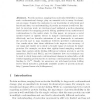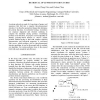53 search results - page 5 / 11 » Is the protein folding an aim-oriented process |
SC
2003
ACM
14 years 1 months ago
2003
ACM
This paper presents a novel, parallel algorithm for generating top alignments. Top alignments are used for finding internal repeats in biological sequences like proteins and gene...
RECOMB
2006
Springer
14 years 8 months ago
2006
Springer
Abstract. Protein motions, ranging from molecular flexibility to largescale conformational change, play an essential role in many biochemical processes. Despite the explosion in ou...
CSB
2003
IEEE
14 years 1 months ago
2003
IEEE
Recognition of a protein’s fold provides valuable information about its function. While many sequence-based homology prediction methods exist, an important challenge remains: tw...
ICIP
2002
IEEE
14 years 9 months ago
2002
IEEE
A protein molecule is made of a long chain of amino acid sequences that fold into a complex three-dimensional structure. It is often the geometrical shapes that determine the prot...
BMCBI
2008
13 years 8 months ago
2008
Background: Post translational modifications (PTMs) occur in the vast majority of proteins and are essential for function. Prediction of the sequence location of PTMs enhances the...


